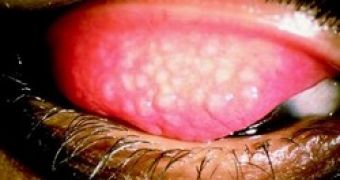A simple "dipstick" test for an eye infection could potentially help save the sight of millions around the world.
The test, developed by a Cambridge University team, can detect trachoma, a disease spread by flies.
A Lancet study involving more than 600 Masai children in Tanzania showed the test to be more effective than an alterative current widely in use. It took just one hour to train local health workers to carry out the tests. The results were evaluated without the benefit of electricity or running water using tables and chairs as makeshift lab benches.
The infection, caused by the bacterium Chlamydia trachomatis, causes the eyelid to fold inward and the lashes to scar the cornea. It is estimated that 84 million people, mainly in the developing world, carry the infection and require treatment. The infection can be cleared by a single dose of a drug called azithromycin.
But because it mainly strikes in poor areas with stretched health systems, it is a leading cause of blindness.
The wafer-thin, 8cm long trachoma dipstick is an adaptation of a test first developed to diagnose the sexually-transmitted form of chlamydia. Professor David Mabey, from the London School of Hygiene and Tropical Medicine, was involved in the trial. He said: "The test is an important advance in the fight against trachoma. At present, the amount of azithromycin pledged by the manufacturer, Pfizer, will not be sufficient to treat everyone living in endemic communities. Yet, much of the drug is wasted in treating communities which no longer need it. The new test will enable program managers to find out for themselves which communities still harbor the infection and thus to focus treatment on the communities which really need it."
Dr Paul Courtright is co-director of the Kilimanjaro Centre for Community Ophthalmology at Tumaini University in Moshi, Tanzania. He said: "The findings from this study will likely lead to a major re-think on how we conduct trachoma control in Africa. It will help us become more targeted in our approach-saving time and money. The potential to accurately identify households and villages with trachoma and provide the interventions needed to eliminate this disease just took a leap forward with this study."

 14 DAY TRIAL //
14 DAY TRIAL //